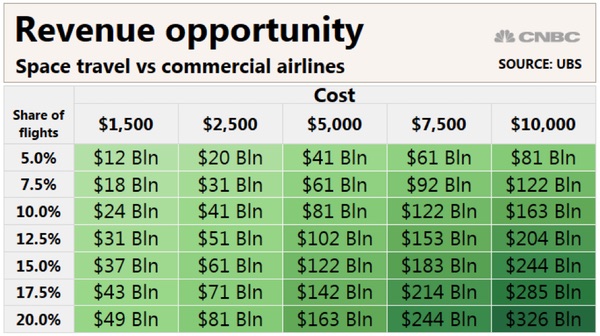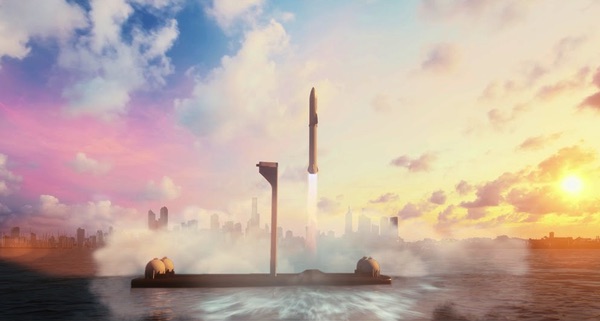Could suborbital point-to-point really be worth $20 billion a year in 2030?by Sam Dinkin
|
| There are several implicit assumptions made by UBS that are flawed. |
On March 18, CNBC published a matrix from a private UBS report published on March 17. It indicates that if suborbital point-to-point spacelines can transport 5 percent the passengers that take 10-hour or longer long-haul airline passenger market of “527,000 [flights] that had an average of 309 [passengers]” and charge $2,500 per flight, it would be a $20 billion/year market.
 UBS sees point-to-point suborbital passenger transportation as a near-term market that may be a large multiple of the current launch market. (credit: UBS/CNBC) |
There are several implicit assumptions made by UBS that are flawed. First, they assume that $2,500 per one-way trip is profitable with 100-person flights. $250,000 in revenue would not cover propellant costs for a two-stage launch. A partially-fueled Starship might have a delta-V of 7.9 kilometers per second, which with atmospheric drag might mimic an ICBM with a maximum speed at atmospheric reentry a bit less than an ICBM’s 7–8 kilometers per second (e.g., 6.4 kilometers per second). The Peacekeeper missile, also known as the MX missile, in service from 1986 to 2005, had a range of 14,000 kilometers.
It’s not clear what payload the Starship might be able to deliver as a single stage. In theory, it has more pressurized volume than the main cabin of an Airbus A380. But its maximum payload, which might have to include the 25,000-kilogram difference between the empty weight of a freight A380 and a passenger A380, is projected at 100,000 kilograms. Approximately 75,000 kilograms is enough for 60 percent more than 309 passengers, weighing an average of 80 to 90 kilograms, carrying 50 to 60 kilograms of luggage plus crew. The 309 total may still be an overestimate of number of passengers because Dragon 2 has more than twice the dry mass of Dragon. UBS had estimated that rockets carrying more than 100 passengers would not be possible, but a dedicated suborbital version of the Starship may be able to be configured to carry the average commercial long-haul flight’s 309 passengers. But even $772,500 in revenue might not be enough to break even in a single-stage launch.
Fortunately, long-haul first class can command $5,000 per flight and with a 30- to 45-minute flight, there would be no need for meals. There also would not need to be as many zero-g toilets per person as the Moon or Mars flight. Concorde could command an even higher price for a flight distance that conventionally took less than 10 hours. At 2 percent inflation, Concorde’s $7,000 one-way seats in 2003 between New York and London or Paris would be worth $12,000 in 2030 dollars. At $12,000 per person, 16 suborbital flights per day carrying about 309 paying passengers would generate $59 million per day or $21.7 billion per year. That might be two flights each way for four city pairs, or a hub-and-spoke arrangement featuring a hub with two flights each way to three other cities and one flight each way between two of the other pairs. This is more than Concorde’s three cities. (More Concorde comparisons can be found in “Pondering the business case of ferrying customers for suborbital point to point,” The Space Review, May 14, 2018.) An estimate of $12,000 per person or $3.7 million per spaceflight might support a two-stage service that goes half way around the world, like the Singapore-Newark’s 19-hour flight.
| It took ten years from Kitty Hawk to the first regular passenger service. The year 2040 is probably a better estimate for point-to-point spaceflight. |
UBS’s 2030 arrival date of a $20 billion/year suborbital point-to-point market sounds to me about as optimistic as predicting in 2004, when the Ansari X Prize was won, that there would be a $95 million per year business for suborbital tourism in 2007 (see “Ka-CHING!”, The Space Review, October 7, 2004.) Getting the risk of suborbital spaceflight flown off might require a test flight a day starting at the beginning 2025 or sooner.
A few words that might mean more years: Regulations. Investment. Spaceports. Weather. Ferries. This is just a tiny fraction of the set of issues that would need to be resolved prior to viable regular passenger service. It took ten years from Kitty Hawk to the first regular passenger service. The year 2040 is probably a better estimate for point-to-point spaceflight given the complexity of modern transportation. We’ll see if The Boring Company can deploy a Los Angeles-San Jose tunnel in the 2030 timeframe: it has much less of a safety risk than spaceflight and there is no equivalent to air traffic control underground. My guess is no suborbital point-to-point and no hyperloop longer than 500 kilometers in 2030.
Will regular passenger service to the Moon start sooner?
Regular service from flying a Starship to low Earth orbit, filling it with propellant, and transferring all the propellant to another Starship with people on it (or transferring the people to the full Starship if that’s easier), might permit regular service to the Moon sooner. Safety would be in a different context, and there would not be any schedule pressure with a weekly flight to the Moon. A company spaceport on the Moon might face much less regulatory scrutiny. Passengers would be much more likely to accept an at-risk regime. They might also be willing to pay $1 million each round trip instead of $24,000. A Moon base by 2035 might, like the International Space Station, also provide a steady trickle of government traffic that could finance development of the vehicle and lunar facilities that might permit a higher flight rate leading to tourist flights by 2040. One flight each way carrying 100 people per week could be $5.2 billion per year. It’s not $20 billion per year, but still about the same as the revenue of the entire launch market today.
All that said, the commercial aviation revenue is projected to be $885 billion in 2019. Introducing a point-to-point suborbital product could convince 5/8ths of one percent of current long-haul fliers to choose suborbital point to point. That is the percentage required to hit $20 billion a year at $12,000 per flight. That supports UBS’ claim thatn when the suborbital point-to-point market does finally arrive, it could be much bigger than the orbital, lunar or Mars markets.
Note: we are temporarily moderating all comments subcommitted to deal with a surge in spam.
